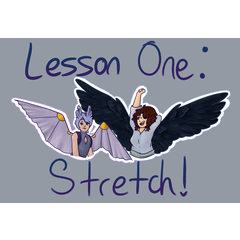How to Draw in Pop Art Style: tips and Steps for the Process
Introduction:
Sometimes we're in an incredibly excited mood, eager to create art that reflects that feeling, or we simply have a job in this style to deliver. Today, I'll share some tips that can help you achieve the pop art style with your strokes!
Step 1: Define the Drawing and Composition
You can find inspiration in many things, scenes, or situations. For good composition, you can use the rule that best applies to your case. In my example, I used the golden ratio.
Step 2: Define the Values
When we're coloring our work, one tool that can help us is defining the values with grayscale, black, and white. This helps to focus on shading and lighting before worrying about colors. Some might skip this step and color directly, but be aware that this could lead to spending a lot of time recoloring and adjusting tones until it feels right if you choose this path.
Step 3: Define the Basic Brushes and Their Characteristics
I usually choose the type of pen for sketching and finalizing the artwork at the beginning because it helps me feel less lost. This also helps me understand the effect I want to convey when coloring, as I like to mimic the movements I would make in a physical drawing both for the final lines and the coloring.
Step 4: Coloring in Layers
At this stage, some people prefer to start with the background, others with the hair or skin. See what feels most comfortable for you. In my case, I started with the background, which would also be the same tone as the skin of my character. From this tone, I chose the colors for shadows and highlights, and I repeated the process with the hair since I already had something in mind for the overall composition of the image.
Step 5: Unleash Your Creativity
Once you've defined the main elements of your drawing, it's time to start having fun. In my case, my drawing represents me as an artist, creating a flow of ideas that come from my digital pen. So, despite having my representation in the background, the pen and what comes from it, or around it, will shape what I'll add to the art over the next few hours.
Since I wanted something that represented a flow of ideas, I could go with a cloud effect or a liquid effect. In the end, I found a middle ground between these two ideas. I added three layers of colors for this effect: gray, cyan, and magenta.
I placed a cyan glitter effect beneath this flow effect and erased some parts of these waves in half-tone, as you can see in the screenshots. At this stage, there isn't a strict rule; it depends on what comes from your heart, your inspiration, or what your client requested!
Step 6: Final Magical Details
Once you feel you've reached where you wanted at the beginning of your painting, it's time to check the final details. In my case, I adjusted colors, brightness, saturation, and added filters as the result got closer to what I had in mind at the start of the project. When you feel you've reached your goal, the point where you look and say, "It looks like I printed this straight from my mind onto the screen!"—that's when you know you've achieved the final result!
Conclusion:
The process of drawing and painting requires both technique and the guidance of your heart. Don't give up if you feel it's taking longer than it should. Just take a break, stretch, eat a fruit, hydrate, and come back inspired by the most upbeat song on your playlist! What I mean is that it's always possible to improve and achieve the work you imagined. Don't give up until you feel the joy of what you've accomplished!
I can't wait to see your art and be amazed by your idea!
Video tip with a summary and process in a fast time-lapse:
I hope I was able to help or inspire you in some way =D











Comentario